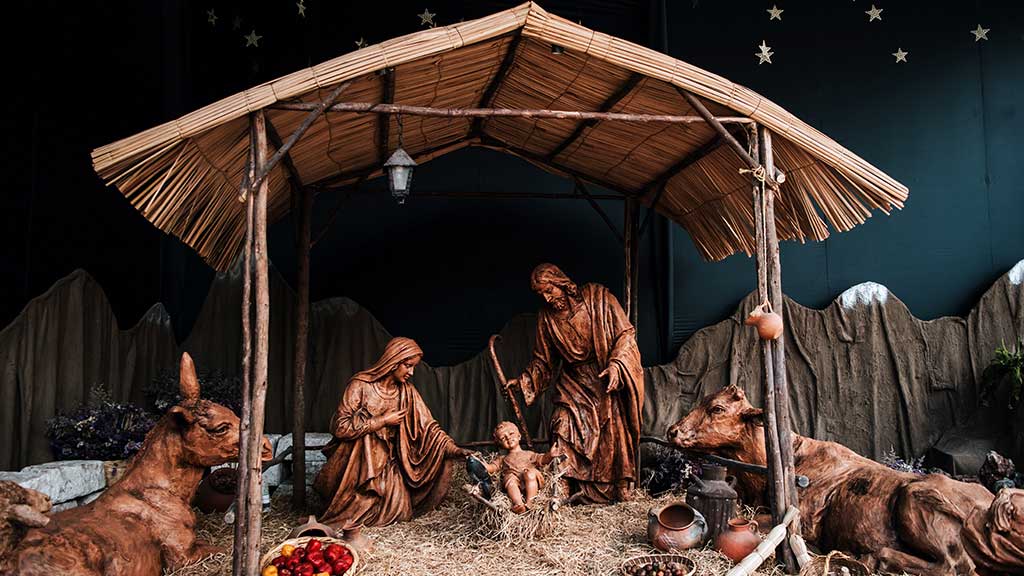Where did the word “Christmas” come from, and what does it mean?
First called the Feast of the Nativity and recognized as early as A.D. 273, the custom spread to Egypt by 432, and to England by the end of the sixth century. By the end of the eighth century, the celebration of Christmas had spread all the way to Scandinavia.

The end of the word (“mas”) in English is “missa” in Latin, a form of the verb “mittere” which means “to send.” Thus Christmas is literally “Christ is sent” or “the sending of Christ.”
Is the use of “Xmas” a secularizing or absenting of Christ from Christmas?
This abbreviation of Christmas actually dates back to the first century church. It is not sourced in our letter “X” but rather the Greek letter X (chi) which is the first letter in Xristos (Christ). Hence it was used initially as an abbreviation for the Messiah (like your own initials). Xmas (using chi, not the letter “X”) means “Christ is sent” – the same as the word “Christmas.” Such abbreviations were common in the Roman world.

Of course, today many may use it with the letter “X” to secularize the holiday and to avoid identifying Christmas with Jesus (“Christ” = “Messiah”= “Anointed One”).
Are Christians guilty of celebrating a pagan holiday (as skeptics allege) by identifying Jesus’ birth on December 25?
The traditional date of Jesus’ birth December 25 is recorded as early as A.D. 273. Two pagan festivals honoring the sun were also celebrated on that day and it is possible that December 25 was chosen to counteract the influence of paganism. To this day, some people feel uncomfortable with Christmas because they think it is somehow tainted by the pagan festivals held on that day. But Christians have long believed that the Gospel not only transcends culture, it also transforms it. In A.D. 320, one theologian answered this criticism by noting, “We hold this day holy, not like the pagans because of the birth of the sun, but because of Him who made it.”
The pagan holiday Saturnalia, for the Greek god Saturn, was celebrated from about December 17-23. We do not know the exact date of Jesus’ birth, but whether it happens to occur at a similar time as any pagan holiday is irrelevant. Christians do not “worship” a pagan holiday or any holiday. We take time to “remember” the birth of Christ, God become flesh, on that day.
Do we know what year that Jesus was born?
Herod the Great was still living at the time of Jesus’ birth (Matthew 2:1ff; Luke 1:5). It is reasonably certain that Herod died just before the Passover (March-April) in 4 B.C. The fact that Herod slew the children 2 yrs and younger (Matthew 2:16) indicates Jesus was less than that, perhaps less than a year, possibly born in December of 5 B.C. Herod would likely have widened the age estimate to make certain of his goal.
The beginning of Herod’s Temple Construction is known to have started in 20 B.C. At the first Passover of Jesus’ ministry (John 2:20) the Jews said the Temple had been under construction for forty-six years. That would place the first year of Jesus’ ministry in A.D. 26 and his birth in 5 B.C. (possibly December?).
The beginning of John the Baptist’s Ministry, according to Luke 3:1, began in the fifteenth year of Tiberius Caesar’s reign. Tiberius became sole ruler in A.D. 14, but was co-ruler with his father Augustus for two years (Robertson). This would put John’s ministry in early A.D. 26 (in the beginning of Tiberius’ fifteenth year, not the end) and Jesus six months later in A.D. 26. Since Jesus was 30 years old when he began his ministry (Luke 3:23), this places his birth about 5 B.C.
The Census (Luke 2:1-2). There are only two known censuses in Palestine: in 8 B.C. and in A.D. 6. One seems too early and the other too late. Ramsay maintains that the census would have been delayed in a distant and insignificant land like Palestine, likely to 6 or 5 B.C.

The Year of Jesus’ Crucifixion. Jesus was crucified on a Friday and on Nisan 14. According to modern astronomical calculations, there are only two years where Nisan 14 falls on a Friday: April 7, A.D. 30 or April 3, A.D. 33. The first date fits other data better with a three-and-a-half year ministry and would place his birth in the 4-5 B.C. range.
NOTE: Our current Gregorian Calendar was not initiated until 1582, by Pope Gregory XIII. It replaced the Julian Calendar. Since the Julian Calendar allowed a positive drift from the solar year, the Gregorian Calendar advanced 10 days (cut 10 days out) at its inauguration from Thursday, Oct. 4 to Friday, Oct. 15.
Is December 25 a realistic possibility for the birth of Jesus?
John the Baptist’s Conception – Priests of the Jerusalem Temple were divided into twenty-four divisions (1 Chronicles 24:5, 7-9; cf Nehemiah 12:4) and each served one week (from Sabbath to Sabbath). Zacharias was of the division of Abijah (Luke 1:5) which drew the eighth lot to serve (see 1 Chronicles). Calculating from the beginning of the Jewish religious year at Passover (about April 1), his division would serve approx. the fourth week of May (eighth week) and again the first week of November (thirty-second week). If the latter date is the one referred to in Luke’s Gospel, and Elizabeth conceived within a week or so after that, then she would be about starting her sixth month of pregnancy in early April (Luke 1:26).
Mary’s conception of Jesus had already occurred when she visited Elizabeth, perhaps in March. Human gestation averages 280 days (forty weeks) but may vary by two weeks either way. The twenty-fifth of December would be in the fortieth week (beginning late March), thus December 25 is a possible date for Jesus’ birth.
Lambing season in Israel – The Awassi ewes in Lebanon, Syria, and Israel lamb in December through January. The shepherds would have been active in the fields to care for the new lambs that were arriving. The birthing caves would have been stocked with swaddling cloths for the male lambs, and likely the ones used by Mary and Joseph for Jesus born in those caves of Bethlehem. Thus Jesus became known as the “Lamb of God.”
Ancient Witnesses – Already in the second century and especially by the fourth, two dates were widely recognized for Jesus’ birthday: December 25 and January 6 (the time between became known as the twelve days of Christmas). The first recorded date of December 25, is in a fourth century Roman almanac listing birth and death dates of notable Christians. The first one listed is December 25: “Christ was born in Bethlehem of Judea.”
How? Tertullian dated Christ’s death on Nisan 14, as being March 25 (on the Roman solar calendar). Christians in the East, using the Greek calendar, dated it to April 6. Of course, nine months later would be December 25 in the West, and January 6 in the East. All Christian groups (West and East) agreed that Jesus was conceived and died on the same date – March 25 (or April 6 in the East). Thus, in the West Christmas is celebrated December 25, and in the East, Christmas is January 6.


